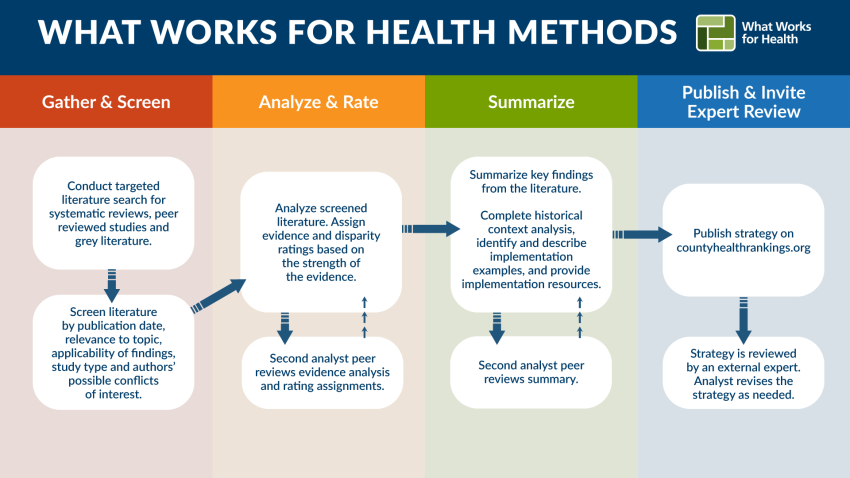
Methods and Ratings
What Works for Health (WWFH) is an evidence clearinghouse based on a model of population health that emphasizes factors that can make communities healthier places to live. Analysts review research to rate strategies’ effectiveness in improving health and advancing equity. Strategies include policies, programs, and systems and environmental changes. This image outlines the process that analysts follow.

What Works for Health methods process
Gather and screen evidence
Literature Search
Analysts begin with a broad literature search to define what will be included in each strategy and identify appropriate search terms. Next, analysts conduct a focused search, prioritizing systematic reviews and peer-reviewed articles. Finally, analysts search grey literature and other evidence clearinghouses that assess policy and program effectiveness.
Learn more about WWFH literature searches and sources.
Literature Screen
Analysts screen articles by date, relevance, applicability of findings, study type and authors’ possible conflicts of interest. They retain the most relevant, recent, rigorous reviews and articles.
Analyze and rate evidence
Analysts record sources’ key findings and quality. This includes consideration for study design, quality, and strength of finding(s). Analysts then assess the strength of the body of evidence, which includes the number and duration of studies and the consistency of their findings. Analysts then assign initial evidence and disparity ratings. A second analyst reviews a summary of the evidence and assigns an independent rating. Final ratings are assigned based on the assessment of both analysts.
Learn about our rating guidelines.
Evidence Rating
Analysts assign strategies’ evidence ratings based on quality, quantity and findings of relevant research. Studies with designs that demonstrate causality are given the most weight. Ratings are based on the likelihood of achieving specific outcomes, labeled expected benefits. Outcomes with weaker or less evidence are labeled potential benefits.
| Evidence Rating | Meaning |
|---|---|
|
Image
| Strategies rated Scientifically Supported are most likely to make a difference. Multiple robust studies show consistently favorable results. |
|
Image
| Strategies rated Some Evidence are likely to work, but more research is needed to confirm effects. These strategies have been tested more than once and results trend favorable. |
|
Image
| Strategies rated Expert Opinion are recommended by credible, impartial experts but have limited research documenting effects. More research, often with stronger designs, is needed to confirm effects. |
|
Image
| Strategies rated Insufficient Evidence have limited research documenting effects. These strategies need more research, often with stronger designs, to confirm effects. |
|
Image
| Strategies rated Mixed Evidence have been tested more than once and results are inconsistent. More research is needed to confirm effects. |
|
Image
| Strategies rated Evidence of Ineffectiveness are not good investments. Multiple studies show consistently unfavorable or harmful results. |
Disparity Rating
Analysts assign each strategy a disparity rating based on research about how a strategy may affect disparities (e.g., racial/ethnic, socioeconomic, or geographic disparities) for health and the social determinants of health. Analysts also consider each strategy’s characteristics, such as population, delivery method and cultural considerations. A strategy’s impact on disparities may change depending on how it is implemented (e.g., tailoring a strategy toward a specific population).
Some strategies also feature an expanded disparity rating to indicate potential impact on disparities and describe the strength of the evidence supporting the rating. The expanded ratings are part of WWFH’s equity analysis.
| Expanded Disparity Rating | Meaning |
|---|---|
|
Image
| Evidence, expert opinion, or intervention design suggests that these strategies have the potential to decrease or eliminate disparities between subgroups. |
|
Image
| Evidence, expert opinion, or intervention design suggests that these strategies have the potential to increase or exacerbate disparities between subgroups. |
|
Image
| Evidence or expert opinion suggest these strategies could increase and decrease disparities between subgroups. |
|
Image
| There is not enough evidence to assess a strategy’s potential impact on disparities. |
| Disparity Rating | Meaning |
|---|---|
| Likely to decrease disparities | Strategies that are likely to reduce differences in health outcomes (i.e., close a gap) |
| Likely to increase disparities | Strategies likely to exacerbate differences |
| No impact on disparities likely | Strategies that generally benefit entire populations |
Summarize and review
Analysts draft a summary of the key findings that support the evidence rating and clarify to which subgroups and outcomes it applies. Strategies with an expanded disparity rating also feature a historical context section and equity considerations. Equity considerations can help users gauge whether a strategy fits their community’s needs and can guide conversations during implementation.
Implementation Examples and Resources
Analysts include examples of strategies in action and tools to support implementation. Examples come from the literature review and from additional focused searches.
Let us know if your community has implemented a strategy and would like to share your story.
Expert Review
External experts are invited to review each strategy and identify ratings they deem incorrect or inappropriate based on their knowledge of literature in the field.
Evi, the WWFH AI-powered librarian
The new WWFH AI-powered librarian tool, Evi, creates answers to user questions based on WWFH’s 400+ evidence-informed strategies and supporting research. Evi summarizes relevant information about improving community health from our database and provides links to specific strategies, along with potential follow-up questions. WWFH analysts will continue to refine Evi’s ability to answer questions following the tool’s launch. For users interested in learning about strategies that mention a specific geographic location or health condition, we recommend using our traditional keyword search. Please note that Evi is currently unable to answer questions about the Health Data section of CHR&R’s website.










